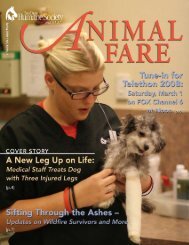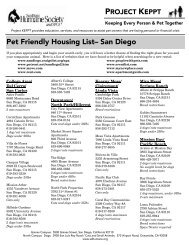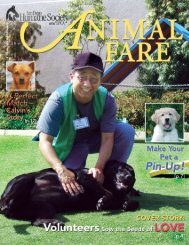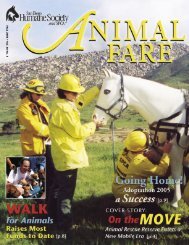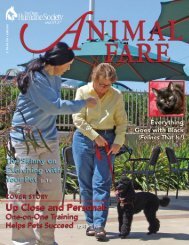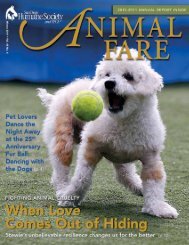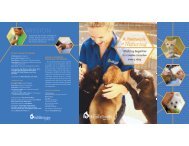F ALL 2006 ⢠V ol. 41 No. 3 - San Diego Humane Society and SPCA
F ALL 2006 ⢠V ol. 41 No. 3 - San Diego Humane Society and SPCA
F ALL 2006 ⢠V ol. 41 No. 3 - San Diego Humane Society and SPCA
You also want an ePaper? Increase the reach of your titles
YUMPU automatically turns print PDFs into web optimized ePapers that Google loves.
A New Leash on Life<br />
In an ideal world our dogs walk loosely<br />
on-leash <strong>and</strong> always take instruction<br />
from us. But it’s not a perfect world,<br />
<strong>and</strong> very often we find that we are the<br />
ones being walked by our dogs. Walking a<br />
dog successfully on a loose leash requires<br />
underst<strong>and</strong>ing of both the physical <strong>and</strong><br />
emotional components inv<strong>ol</strong>ved.<br />
As in all training, working on leash<br />
walking should be fun <strong>and</strong> relaxed for<br />
both you <strong>and</strong> your pet. This is especially<br />
true when working with shy or excitable<br />
dogs. Leash walking should never become<br />
a battle between you <strong>and</strong> your dog, <strong>and</strong><br />
should also never include anything that<br />
could damage your relationship with your<br />
canine companion.<br />
So, why do dogs pull on leashes?<br />
First, pulling behavior stems from<br />
“opposition reflex,” or a dog’s instinctive<br />
behavior to lean into pressure on their<br />
bodies, which turns many pups into<br />
bulldozers when going out for a daily<br />
str<strong>ol</strong>l. One of the most important aspects<br />
of leash walking is having the equipment<br />
best suited to your dog. The proper<br />
equipment will be well-fitted, serve as<br />
an effective management <strong>and</strong>/or training<br />
to<strong>ol</strong>, <strong>and</strong> will not be harmful to your dog.<br />
We discourage the use of devices that<br />
can physically hurt your dog, such as<br />
Photo: Softouch Concepts<br />
shock c<strong>ol</strong>lars, choke chains <strong>and</strong> prong/<br />
pinch c<strong>ol</strong>lars. While some people may<br />
see results with this equipment, it can<br />
significantly damage your relationship<br />
with your dog. In fact, when you train<br />
using intimidation or pain this can<br />
actively teach your dog to be afraid of you,<br />
when you want the opposite – you want<br />
your dog to have fun walking with you!<br />
Fortunately, there are many types<br />
of effective, humane <strong>and</strong> pet-friendly<br />
walking gear that can help train your<br />
dog in a positive way:<br />
Flat Buckle C<strong>ol</strong>lar: If your dog<br />
walks reasonably well on-leash, a flat<br />
buckle c<strong>ol</strong>lar may be all you need for an<br />
enjoyable str<strong>ol</strong>l with your buddy. These<br />
c<strong>ol</strong>lars should be made of leather or<br />
sturdy webbing material, <strong>and</strong> always<br />
check the buckle to ensure it is strong<br />
<strong>and</strong> will not pop open should your dog<br />
become excited <strong>and</strong> lunge to the end of<br />
his leash.<br />
Leash walking should<br />
never become a battle<br />
between you <strong>and</strong> your<br />
dog, <strong>and</strong> should also<br />
never include anything<br />
that could damage your<br />
relationship with your<br />
canine companion.<br />
Martingale C<strong>ol</strong>lar: This type of<br />
“limited slip” c<strong>ol</strong>lar has a loop that<br />
contracts a small amount should your<br />
dog pull or try to back out of his c<strong>ol</strong>lar.<br />
This is not tight enough to “choke” your<br />
dog; it simply provides a bit of extra<br />
contr<strong>ol</strong> when it is needed <strong>and</strong> also<br />
distributes the pressure around the neck<br />
so that the dog is less likely to pull.<br />
Head Halters: Head halters, which<br />
have a ring on the underside of the dog’s<br />
chin where the leash attaches, make it<br />
easy for you to turn your dog’s head gently<br />
in order to “steer” him away from distractions<br />
or in the direction you would like to<br />
go. There are many kinds of head halters<br />
on the market, but the two that we like<br />
best are the Gentle Leader ® <strong>and</strong> the<br />
Comfort Trainer. A properly fitted<br />
halter will still allow your dog to pant,<br />
drink water, <strong>and</strong> eat treats. Whichever<br />
one you choose, it is very important to<br />
never jerk your dog’s leash – this can<br />
cause very serious damage to your dog’s<br />
neck.<br />
SENSE-ation Harness: Our other<br />
favorite leash walking product is the<br />
SENSE-ation body harness.<br />
This harness is different<br />
from the traditional body<br />
harness in that the leash<br />
attaches to a ring at<br />
the dog’s breastbone<br />
rather than on the dog’s<br />
back. The SENSE-ation works<br />
similarly to a head halter in that it places<br />
far less pressure on the dog’s body <strong>and</strong><br />
instead of creating a backward pulling<br />
feeling, these harnesses are designed to<br />
work with pulling a leash upwards, sideways<br />
or forward. As long as a leash is not<br />
pulled backwards, the pet does not feel<br />
the need to lean into the harness, which<br />
reduces pulling on the leash.<br />
Whichever to<strong>ol</strong> you choose for leash<br />
walking, it is important to go slowly.<br />
This is especially true for head halters –<br />
having something on their face is a novel<br />
experience for most dogs, <strong>and</strong> so will<br />
require slow introduction using treats<br />
<strong>and</strong> praise. Remember our mantra<br />
– training should be fun for both you<br />
<strong>and</strong> your dog! Make it into a game, <strong>and</strong><br />
your dog will love strutting their stuff in<br />
new leash walking attire!<br />
The Behavior <strong>and</strong> Training<br />
Department offers Leash Walking<br />
workshops <strong>and</strong> private Leash Walking<br />
training sessions. We have a Behavior<br />
Helpline at (619) 299-7012, ext. 2244 to<br />
advise you on the best choice for your<br />
dog. You can also find all of the above<br />
mentioned walking gear at Muttique, the<br />
<strong>Humane</strong> <strong>Society</strong>’s on-campus store.<br />
mB<br />
Photo: Softouch Concepts<br />
16 www.sdhumane.org<br />
AnimalFare • Fall <strong>2006</strong>




